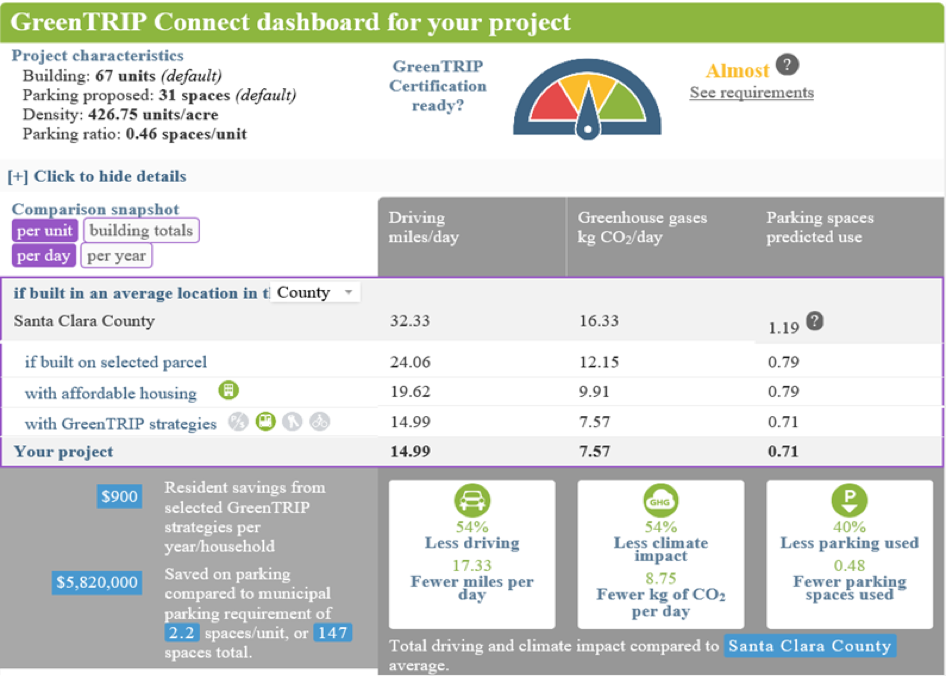
Transportation Demand Management
Case Study – Transform’s GreenTRIP Certification
A Guide to Lower Impact, More Affordable Housing
Place-type: Applicable to all place-types
Overview
The GreenTRIP Program was launched in 2008 by TransForm, a Bay Area non-profit organization that promotes walkable communities with excellent transportation choices. GreenTRIP includes several innovative strategies for the evaluation and certification of housing development projects. It also quantifies the projected impact on the transportation infrastructure and environment. The GreenTRIP includes three main tools: GreenTRIP Connect, GreenTRIP Parking Database, and GreenTRIP Certification.
- GreenTRIP Connect is a calculator with the capability to assess the mobility impacts of development projects. The model compares development parameter inputs, such as the number of housing units and parking spaces, to the underlying parcel-level demographic, employment, and transit data.
- GreenTRIP Parking Database enables developers to examine whether they can reduce the cost of housing development through innovative parking strategies. The parking database is built to showcase underutilized parking and guide decisions regarding parking supply and management.
- GreenTRIP Certification, which has been used for more than 25 housing projects in the Bay Area, recognizes developments that meet specific requirements, such as right-sized parking.

GreenTRIP Connect Dashboard
Outcomes
GreenTRIP prioritizes various strategies that reduce automobile dependency. Strategies include site placement that is walkable with shops, stores, schools, and other desirable destinations nearby; availability of safe and convenient transit, bike, and car share services; and transit subsidies provided by developers. The following two projects highlight the challenges and outcomes in applying the GreenTRIP model and GreenTRIP certification process:
- 1. Eagle Park Apartments, 1701 West El Camino Real, Mountain View, CA has 67 affordable housing units for veterans and contains 31 parking spaces for residents. Travel demand mitigation measures of the GreenTRIP model applied for this project include:
- A reduced parking requirement to 0.46 parking spaces per housing unit
- Free Santa Clara Valley Transportation Authority (VTA) transit passes for all residents
- At least one bicycle parking space per unit
- A developer commitment to an annual transportation and parking monitoring survey of project residents
According to GreenTRIP, the approved project is projected to reduce the Vehicle Miles Traveled (VMT) per resident by 26 miles per day compared to the base case without travel demand mitigation measures. The base case, or “business as usual”, did not assume any reduction in zoning code parking requirements, lacked a free car share program, a shared bicycle fleet, on-site bicycle repair, and free transit passes, and did not “unbundle”, or separate, the cost of the housing unit from the cost of the parking required for the unit.
- 2. 1450 Sherwin Street, Emeryville, CA is on 8.6 acres of land and includes 500 residential units. Travel demand mitigation measures of the GreenTRIP model applied to this project include:
- One parking space per unit
- A free car share program for all residents for 40 years
- 100% unbundled parking that separates residents’ parking costs from their rental costs
- A shared bicycle fleet
- On-site bicycle repair facilities
- Free AC Transit Easy Passes (AC Transit bus passes) for residents for five years
GreenTRIP analysis estimates that each household will drive 59% less and produce 51% fewer greenhouse gas (GHG) emissions with the transportation demand management measures listed above in place, compared to the “business as usual” base case.
Challenges and Lessons Learned
The challenge for TransForm is to maintain an updated database for travel and demographic data while potentially extending the model to include other states so that GreenTRIP remains useful and can be applied to a wider geographic area over time.